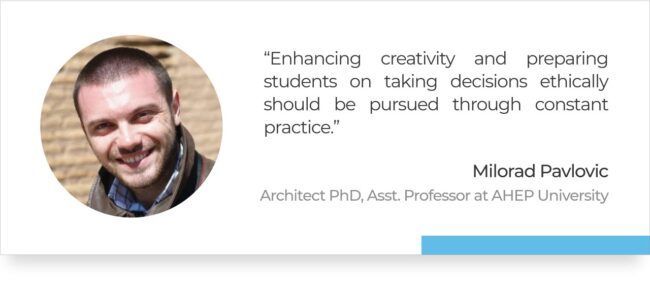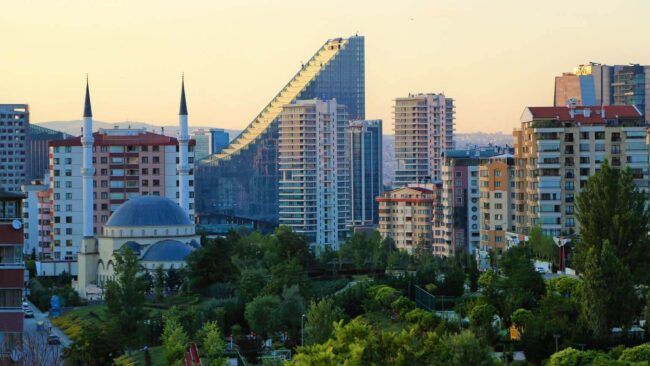When you need references on a particular subject or discipline, the best thing to do is to talk to an expert in the field. And this is precisely what you should do if you are curious or interested in masonry structures.
The numerous articles and references published by Milorad Pavlovic prove that he is a true expert on the subject. And not only as an architectural professional but also as an academic. It is not without reason that he completed his PhD studies in the prestigious university IUAV of Venice and he is currently an academic in the Department of Architecture of the AHEP University in Turkey.

But he is not only an expert in this type of structure, which is very present in architecture, he is also a good friend of our School of Architecture and he has even participated as a panel member in some of the final projects of our students.
A conversation with Milorad Pavlovic is always an opportunity to learn, whether it is about masonry, trends or emerging studios at the far end of the continent.
In your Faculty of Architecture you try to foster creativity and ethics in your students: are these two key elements in the education of an architect, other than the technical knowledge? How do you reinforce these ideas with your students in class?
As well known, architectural education is a quite complex field and hardly can be reassumed in two key elements. However, creativity and ethics might be considered as the two aspects that characterize not only the architectural education but also the professional practice. Nevertheless, the technical knowledge can be omitted from the architectural background. Yet, a differentiation should be made between the disciplines that belong entirely to the academic sphere and those that can, or need to be learned, on the specific fields.
From this point of view, I believe that enhancing creativity and preparing students on taking decisions ethically should be pursued through constant practice and a university-culture oriented environment. In our faculty, the principles of ethics are thought throughout a theoretical course offered to the freshmen students, whereas creativity is fostered in every laboratory course, starting from the Basic Design, passing through the Introduction to Architectural Design, and continuing with the chain of Architectural Design Studio courses. Parallelly to these classes, the technical knowledge is fostered through theoretical and application courses, as well as two internship activities.
Many of your articles talk about masonry structures: domes, bell towers, chimneys… What made you specialize in this area?
Certainly, the prestigious historic architecture of Italy, as well as its minor architecture, had a strong influence on me, arousing at first the desire to study the discipline and then to get specialized on masonry structures. Besides, the consequences of the earthquake that hit the city of L’Aquila in the year 2009 stimulate my interest in the historic architecture, in particular for the mechanics of masonry structures.
Therefore, during my Master and Ph.D. programs at University IUAV of Venice, under the supervision of Prof. Antonella Cecchi, I concentrate my researches on structural aspects of historic masonry structures. Successively, as lecturer in Alanya HEP University, I focused on the analyses of masonry structures as a tool for teaching basic principles of architecture-structure-function relations. Due to the static principles and economy of the materials, masonry structures certainly offer such opportunities, either we consider historic examples or more recent projects. Understanding the principles of the past should be the first step in setting the basis for contemporary architecture, as done through centuries by architects such as Palladio, Le Corbusier, or Louis Kahn.
I really believe that studying masonry structures can be a font of inspiration for future architects, not only for the aspects mentioned above but also as a form of respect for the local communities, in terms of usage of the materials, architectural proportions, and traditional techniques. Among the recent and contemporary architectural projects, I would suggest to the freshmen and sophomore students to analyze examples such as the residential complex designed by Gino Valle on Giudecca island in Venice or the “House 01” in Dublin by TAKA Architects.
In our degree we have this concept we like to call ArchiTRIPture, in which students learn Architecture visiting different Spanish and international destinations throughout their studies. So far we have been to Germany, Denmark, Portugal… should we consider Turkey as one of our next destinations?
From a visit and analysis of architecture in Turkey, students may at first observe a context in which Middle-Eastern, Anatolian and European traditions come across continuously, sometimes in harmony, sometimes with significant contrasts. Traces of Seljuk, Roman, Byzantine, and Ottoman empires can be admired in many locations, contra posed with recent contemporary architecture. Such contraposition, which characterizes most of the famous destinations like Istanbul, Izmir, or Antalya offers the opportunity to experience this vivid and colorful mixture of different cultures. A variety, that after a more attentive observation can become a font of inspiration. Besides the main cities and their contradictory images, the country offers the possibility of visiting settlements such as Mardin or Hatay, where historic synagogues, churches, and mosques convive together, and cities mostly developed after the institution of the Turkish Republic, like the capital Ankara.
The city of Ankara indeed offers interesting examples of Modernist Architecture and the opportunities of admiring buildings designed by European architects such as Ernst Egli, Clemens Holzmeister, and Bruno Taut, but also significant approaches by national architects like Kemalettin, Şevki Balmumcu, or Emin Halid Onat.
Located in the north of Ankara, the city of Safranbolu might be considered an important part of the ArchiTRIPture, where students would have a chance to admire the characters of traditional Anatolian architecture.
As the core activity of the ArchiTRIPture is travelling, worthy of consideration can be visits to the intercity bus hubs, such as, Kayseri West City Terminal, Nevşehir Terminal or Lüleburgaz – Kırklareli Terminal. Such com-plexes, besides their architectural characters, reflect the idea of traveling in Turkey, remarked by long distances, and journeys preferably calculated in terms of hours instead of kilometers.
What are the latest trends in modern architecture in Turkey?
The diapason of contemporary architecture in Turkey is extremely variable. It encompasses projects of international architects, local architects with consolidated experience, and more experimental approaches. Among the residential projects realized in recent years, the Dolunay Villa by Foster & Partners and the Ma Vie La house by Selim Erdil can be highlighted for their valuable approaches, usage of the materials, and integration to the site.

As regards the public buildings designed by the international architects, particular attention deserve the Modern Art Museum by Kengo Kuma & Associates, located in Odunpazarı (Eskişehir) and the School of Foreign Languages at the Izmir University of Economics by Gudjon Erlendsson and Özlem Akın.
By all of local architects, the EAA – Emre Arolat Architecture office, can probably claim the biggest success in both national and international fields, with a wide range of projects and prizes. However among the emerging studios, in my opinion, an eye should be kept on the proposals by the Istanbul-based office SO?. Founded by Sevince Bayrak and Oral Göktaş, in recent years the studio has proposed works not only in the field of architecture and urban design but also temporary and permanent installations, with distinguished exhibitions in MoMA and MAXXI.
Is there any Spanish architect that you personally admire, or a project that you especially like in our country?
Spain is very famous for its architecture, not only for the meaningful examples and world-famous architects but also for the design of cities, historic towns, and minor architecture. While thinking about Spain, it’s impossible to omit names such as Ildefons Cerdà, Antoni Gaudí, Félix Candela, or Santiago Calatrava.
Calatrava indeed, is the Spanish architect whose projects I mostly experienced. At first in Switzerland, while visiting the train stations in Zürich and Luzern, then in Italy, while crossing daily for 8 years the Constitution Bridge in Venice, and lastly in Spain while exploring the City of Arts and Sciences in Valencia. From these experiences, certainly I had chance to admire the iconic design and the unique structural language.
“Understanding the principles of the past should be the first step in setting the basis for contemporary architecture”
However, it’s been during my first trip to Andalucía region that I had chance to meet with more profound architectural design approaches. That journey from Seville to Granada, via Córdoba, allowed me to contact very fascinating locations and buildings. At first, the San Pablo airport in Seville, designed by Rafael Moneo, gave me the opportunity to experience a different concept for the airport design, characterized by solid masses and references with local traditions. As for the next step, the museum of Madinat Al Zahra by Nieto Sobejano, enhanced in me the aspects of architectural and landscape integration in an excellent manner. One more museum captured and maintained vivid the attention for the space organization and the usage of light: the Caja Granada Museum by Alberto Campo Baeza. Experiencing these 3 architectures brought to me a profound admiration for the ways that the architects respect the sites and the existing textures, but at the same time providing high-quality space solutions and innovative approaches.


























